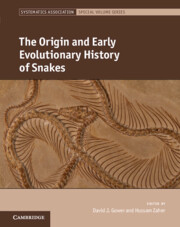
-
Select format
-
- Publisher:
- Cambridge University Press
- Publication date:
- July 2022
- August 2022
- ISBN:
- 9781108938891
- 9781108837347
- Dimensions:
- (254 x 203 mm)
- Weight & Pages:
- 1.38kg, 488 Pages
- Dimensions:
- Weight & Pages:
- Subjects:
- Life Sciences, Evolutionary Biology, Zoology
You may already have access via personal or institutional login- Subjects:
- Life Sciences, Evolutionary Biology, Zoology
Book description
Snakes comprise nearly 4,000 extant species found on all major continents except Antarctica. Morphologically and ecologically diverse, they include burrowing, arboreal, and marine forms, feeding on prey ranging from insects to large mammals. Snakes are strikingly different from their closest lizard relatives, and their origins and early diversification have long challenged and enthused evolutionary biologists. The origin and early evolution of snakes is a broad, interdisciplinary topic for which experts in palaeontology, ecology, physiology, embryology, phylogenetics, and molecular biology have made important contributions. The last 25 years has seen a surge of interest, resulting partly from new fossil material, but also from new techniques in molecular and systematic biology. This volume summarises and discusses the state of our knowledge, approaches, data, and ongoing debates. It provides reviews, syntheses, new data and perspectives on a wide range of topics relevant to students and researchers in evolutionary biology, neontology, and palaeontology.
Contents
Metrics
Full text views
Full text views help Loading metrics...
Loading metrics...
* Views captured on Cambridge Core between #date#. This data will be updated every 24 hours.
Usage data cannot currently be displayed.
Accessibility standard: Unknown
Why this information is here
This section outlines the accessibility features of this content - including support for screen readers, full keyboard navigation and high-contrast display options. This may not be relevant for you.
Accessibility Information
Accessibility compliance for the PDF of this book is currently unknown and may be updated in the future.


